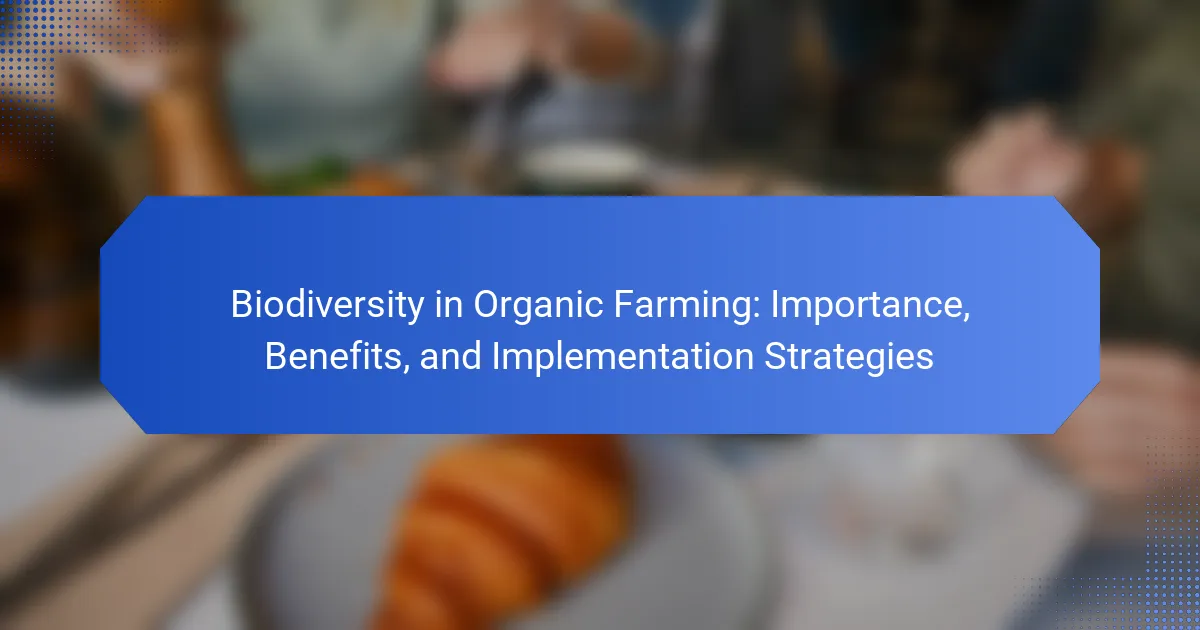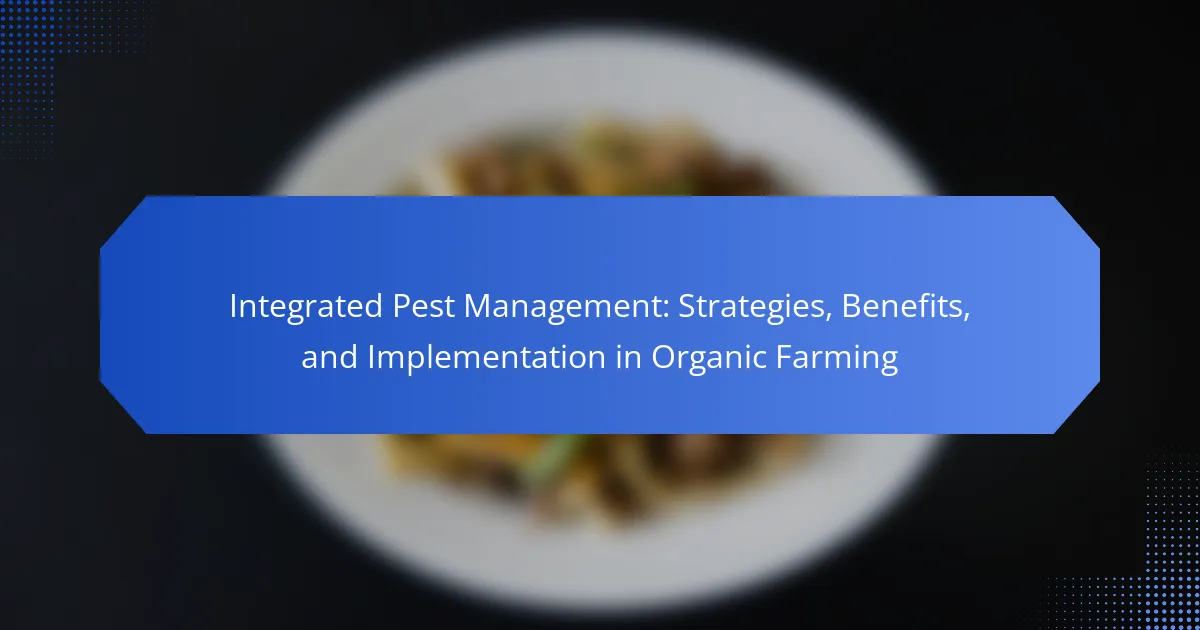Agroecology is a sustainable agricultural approach that integrates ecological principles with farming practices to enhance resilience and productivity. Key principles of agroecology include promoting biodiversity, prioritizing soil health, utilizing local knowledge, and ensuring social equity in resource management. Common agroecological practices such as crop rotation, intercropping, cover cropping, and agroforestry contribute to improved ecosystem health and reduced reliance on chemical inputs. The benefits of agroecology extend to enhanced biodiversity, better soil health, and increased resilience to climate change, often resulting in higher yields compared to conventional farming methods. This article explores the fundamental principles, practices, and ecological impacts of agroecology.

What are the fundamental principles of agroecology?
Agroecology is based on several fundamental principles. These principles include biodiversity, which enhances ecosystem resilience. Soil health is prioritized, promoting organic matter and microbial activity. Agroecology emphasizes local knowledge, integrating traditional practices with scientific research. It advocates for sustainable resource management, minimizing external inputs. Social equity is also a key principle, ensuring fair access to resources and decision-making. Lastly, agroecology promotes synergy between crops and livestock, enhancing overall farm productivity. These principles collectively aim to create sustainable and resilient agricultural systems.
How do these principles promote sustainable agriculture?
Agroecology principles promote sustainable agriculture by enhancing biodiversity and soil health. They encourage crop rotation and polyculture, which improve ecosystem resilience. These practices reduce reliance on chemical inputs, lowering environmental pollution. Agroecology also emphasizes local knowledge and community involvement, fostering sustainable practices. According to the Food and Agriculture Organization, agroecological practices can increase yields while reducing greenhouse gas emissions. This approach supports the long-term viability of farming systems. Overall, these principles create a more balanced relationship between agriculture and the environment.
What role does biodiversity play in agroecology?
Biodiversity plays a crucial role in agroecology by enhancing ecosystem resilience and productivity. It supports a variety of species that contribute to nutrient cycling, pest control, and pollination. Diverse plant and animal species improve soil health and structure. This diversity also increases the system’s ability to withstand environmental stresses. For instance, diverse crop rotations can reduce pest outbreaks and improve yields. Studies show that farms with higher biodiversity often have better economic returns. The Food and Agriculture Organization states that biodiversity is essential for sustainable agricultural systems.
How does agroecology enhance soil health?
Agroecology enhances soil health by promoting biodiversity and sustainable farming practices. It encourages crop rotation, which improves soil structure and fertility. The integration of cover crops prevents erosion and enhances nutrient cycling. Organic matter is increased through composting and reduced tillage. These practices lead to a more resilient soil ecosystem. Research shows that agroecological methods can increase soil organic carbon by up to 30%. Healthy soils support better water retention and microbial activity. This results in improved plant growth and productivity.
Why is agroecology important for food security?
Agroecology is crucial for food security because it enhances sustainable agricultural practices. It promotes biodiversity, which leads to healthier ecosystems. Diverse crops can withstand pests and diseases better than monocultures. Agroecology also improves soil health, increasing crop yields over time. According to the Food and Agriculture Organization (FAO), agroecological practices can boost food production by up to 80% in some regions. Additionally, it reduces dependence on chemical inputs, lowering costs for farmers. This approach also supports local food systems, making communities more resilient to food shortages. Overall, agroecology contributes significantly to long-term food security.
How does agroecology support local communities?
Agroecology supports local communities by enhancing food security and promoting sustainable farming practices. It encourages biodiversity, which improves ecosystem resilience. Local farmers benefit from reduced input costs through organic practices. Agroecology fosters community engagement and knowledge sharing among farmers. It also strengthens local economies by creating markets for local produce. Studies show that agroecological practices can increase yields by 20-50% compared to conventional methods. Additionally, agroecology contributes to social equity by empowering marginalized groups. Overall, it creates a more sustainable and equitable food system for local communities.
What impact does agroecology have on nutrition?
Agroecology positively impacts nutrition by promoting diverse and nutrient-rich food systems. It enhances food security through sustainable agricultural practices. These practices improve soil health and biodiversity, leading to better crop yields. Increased biodiversity results in a variety of crops, which provides a broader range of nutrients. Studies show that agroecological systems can produce up to 40% more food per unit area compared to conventional methods. This increase supports better dietary diversity. Additionally, agroecology encourages local food production, reducing reliance on processed foods. Local sourcing often leads to fresher produce, which retains more nutrients. Overall, agroecology contributes to healthier diets and improved nutrition outcomes.

What practices are commonly associated with agroecology?
Agroecology is associated with practices that enhance sustainable farming and ecosystem resilience. Common practices include crop rotation, which improves soil health and reduces pests. Intercropping is another practice that promotes biodiversity and maximizes land use. Cover cropping helps prevent soil erosion and improves nutrient cycling. Agroforestry integrates trees into agricultural landscapes, providing habitat and reducing carbon footprints. Reduced tillage minimizes soil disturbance and enhances soil structure. Integrated pest management combines biological, cultural, and chemical tools for pest control. These practices collectively contribute to sustainable agricultural systems and environmental health.
How can agroecological practices be implemented on farms?
Agroecological practices can be implemented on farms through diverse methods. Farmers can adopt crop rotation to enhance soil fertility and disrupt pest cycles. Integrating livestock with crops promotes nutrient recycling and biodiversity. Cover cropping prevents soil erosion and improves soil structure. Utilizing organic fertilizers reduces reliance on synthetic chemicals. Implementing agroforestry combines trees with crops for improved ecosystem services. Water conservation techniques, such as rainwater harvesting, optimize resource use. Participatory research with local communities ensures practices are context-specific and culturally appropriate. Evidence shows that farms using these methods often yield higher resilience to climate change impacts.
What are the methods for crop rotation in agroecology?
Crop rotation in agroecology involves several methods. These methods include changing the type of crops grown in a specific area over time. One common method is the sequential cropping, where different crops are planted in succession. Another method is intercropping, which involves planting two or more crops simultaneously in the same field. Cover cropping is also used; it involves planting crops specifically to improve soil health.
Crop rotation can help prevent soil depletion and reduce pest populations. Studies show that rotating crops can enhance biodiversity. This practice improves soil structure and fertility through varied root systems. Additionally, it can lead to higher yields over time. Research indicates that diverse crop rotations can decrease disease incidence.
Overall, these methods contribute to sustainable farming practices in agroecology.
How does intercropping benefit agroecological systems?
Intercropping benefits agroecological systems by enhancing biodiversity and improving soil health. It allows different crops to grow together, maximizing resource use. This practice reduces pest populations through natural predation and competition. Additionally, intercropping can increase crop yields compared to monocultures. Studies show that intercropping can lead to a 20-50% increase in overall productivity. It also improves nutrient cycling by utilizing various root structures and growth habits. Furthermore, intercropping can enhance resilience to climate change by diversifying crop species. This diversity helps stabilize ecosystems and supports beneficial organisms.
What technologies support agroecological practices?
Technologies that support agroecological practices include precision agriculture, agroforestry systems, and organic farming techniques. Precision agriculture utilizes data and technology to optimize field-level management. This approach enhances crop yields while minimizing resource use. Agroforestry combines agriculture and forestry, promoting biodiversity and improving soil health. Organic farming techniques involve using natural inputs and processes, reducing chemical dependency. These technologies collectively contribute to sustainable farming practices. Studies show that these methods can increase resilience to climate change and improve ecosystem services. For instance, a report by the Food and Agriculture Organization highlights the effectiveness of agroecological practices in enhancing food security.
How do organic farming techniques fit within agroecology?
Organic farming techniques align closely with agroecology by emphasizing sustainable practices. Both focus on enhancing biodiversity and soil health. Organic farming utilizes crop rotations, cover crops, and composting. These methods improve soil fertility and structure, which are key principles of agroecology. Moreover, organic farming reduces chemical inputs, promoting ecological balance. Research indicates that organic practices can increase resilience in agroecosystems. Studies show that organic farms often support a higher diversity of beneficial insects. This synergy enhances ecosystem services, such as pollination and pest control. Thus, organic farming techniques are integral to the principles of agroecology.
What role do agroforestry systems play in agroecology?
Agroforestry systems play a critical role in agroecology by integrating trees and shrubs into agricultural landscapes. This integration enhances biodiversity, improves soil health, and increases resilience to climate change. Agroforestry practices can lead to better water management and reduced erosion. They also provide additional income sources through timber and non-timber forest products. Research indicates that agroforestry can increase crop yields by up to 30% in some contexts. The diversity of species in agroforestry systems supports ecosystem services, including pollination and pest control. Overall, agroforestry contributes to sustainable agricultural practices and ecosystem restoration.

What benefits does agroecology provide to ecosystems?
Agroecology provides numerous benefits to ecosystems. It enhances biodiversity by promoting a variety of crops and livestock. This diversity supports a range of organisms, including beneficial insects and soil microbes. Agroecology improves soil health through practices like crop rotation and cover cropping. Healthier soils lead to better water retention and nutrient cycling. It also reduces the need for chemical inputs, minimizing pollution and harm to non-target species. Agroecological practices can increase resilience to climate change by improving ecosystem functions. Studies show that agroecological farms often have higher yields over time compared to conventional farms. This is due to their sustainable management of resources and ecological processes.
How does agroecology contribute to ecosystem resilience?
Agroecology enhances ecosystem resilience by promoting biodiversity and sustainable practices. It encourages diverse cropping systems that improve soil health. Healthy soils can better withstand climate variability and extreme weather. Agroecological practices, such as crop rotation and intercropping, enhance nutrient cycling. This leads to reduced dependency on chemical fertilizers. Additionally, agroecology supports natural pest control mechanisms. This reduces the need for synthetic pesticides. Studies show that agroecological farms are more resilient to pests and diseases. They often maintain higher yields during adverse conditions. These factors collectively contribute to a more robust ecosystem.
What are the ecological benefits of reduced chemical inputs?
Reduced chemical inputs enhance ecological health by promoting biodiversity. This practice decreases the toxicity in soil and water, improving habitat quality for various organisms. Reduced chemical usage supports beneficial insect populations, such as pollinators and natural pest predators. Studies show that organic farming, which typically uses fewer chemicals, can increase species richness by up to 30%. Additionally, lower chemical inputs lead to improved soil health, enhancing its capacity to sequester carbon. Healthier soils contribute to better water retention and reduced erosion. Overall, reduced chemical inputs foster a more resilient ecosystem, capable of sustaining diverse life forms.
How does agroecology influence water conservation?
Agroecology influences water conservation by promoting sustainable farming practices that enhance soil health and water retention. These practices include crop rotation, cover cropping, and reduced tillage. Crop rotation improves biodiversity and soil structure, leading to better water infiltration. Cover crops protect the soil and prevent erosion, which helps maintain moisture. Reduced tillage minimizes soil disturbance, preserving its structure and capacity to retain water. According to a study by the Food and Agriculture Organization, agroecological practices can increase water retention in soils by up to 50%. This results in reduced irrigation needs and improved resilience to drought conditions.
What are the social and economic impacts of agroecology?
Agroecology has significant social and economic impacts. It promotes sustainable farming practices that enhance food security. This approach fosters community resilience and strengthens local economies. Agroecology encourages biodiversity, which can improve crop yields. It also reduces reliance on external inputs, lowering costs for farmers. Research shows that agroecological practices can increase farmers’ income by up to 50%. Additionally, agroecology supports social equity by empowering marginalized communities. It provides training and resources, enabling better access to markets. Overall, agroecology contributes to healthier ecosystems and sustainable livelihoods.
How does agroecology promote equitable access to resources?
Agroecology promotes equitable access to resources by emphasizing local knowledge and sustainable practices. It empowers smallholder farmers and marginalized communities. Agroecology encourages diverse cropping systems, which enhances resilience and food security. This approach reduces dependency on external inputs, allowing communities to utilize local resources effectively. Research shows that agroecological practices can increase yields while preserving biodiversity. Additionally, agroecology fosters social equity by promoting fair trade and collaborative networks. These networks ensure that resources are shared and accessible to all community members.
What economic advantages does agroecology offer farmers?
Agroecology offers several economic advantages to farmers. It reduces input costs by promoting organic farming practices. Farmers can save on synthetic fertilizers and pesticides. Agroecological methods often lead to improved soil health. Healthier soils increase crop yields over time. This can enhance food security and farm profitability. Crop diversity in agroecology can mitigate risks from pests and diseases. Studies show that diverse systems can be more resilient to climate change. Additionally, agroecology can open new markets for organic and sustainably produced goods.
What are best practices for adopting agroecological principles?
Best practices for adopting agroecological principles include diversifying crops and integrating livestock. Crop diversification enhances resilience against pests and diseases. It also improves soil health and increases biodiversity. Integrating livestock can provide natural fertilizers and improve nutrient cycling. Utilizing cover crops is another effective practice. Cover crops protect soil from erosion and improve soil structure. Implementing agroforestry systems combines trees with crops, enhancing ecosystem services. Reducing chemical inputs minimizes environmental impact and promotes ecological balance. Engaging with local communities fosters knowledge sharing and strengthens local food systems. These practices collectively enhance sustainability and productivity in agroecological systems.
Agroecology is a sustainable agricultural approach grounded in principles such as biodiversity, soil health, local knowledge integration, sustainable resource management, social equity, and crop-livestock synergy. This article explores how these principles promote sustainable agriculture, enhance food security, and support local communities while improving nutrition and ecosystem resilience. It also examines common agroecological practices like crop rotation, intercropping, and agroforestry, alongside the economic and social benefits they provide to farmers and communities. Furthermore, the article highlights the role of reduced chemical inputs and innovative technologies in fostering healthier ecosystems and sustainable livelihoods.



